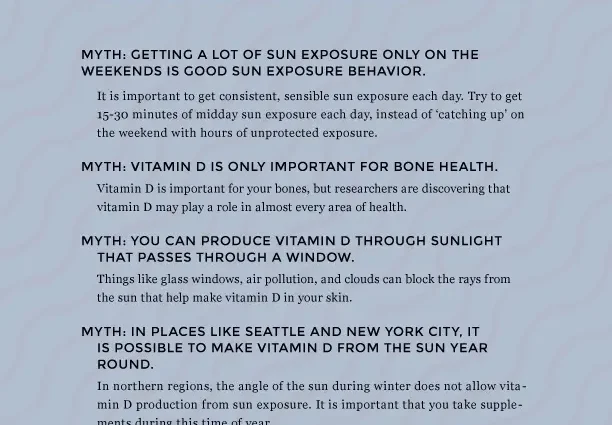Contents
- Myth 1. Prevention of vitamin D deficiency – long exposure to the sun
- Myth 2: Sunscreen interferes with vitamin D synthesis.
- Myth 3. You can get the right dose of vitamin D from food.
- Myth 4. Vitamin D is important for babies, so they do not need UV protection.
- Myth 5. Dark people do not have problems with vitamin D.
- Myth 6. A lot of sunbathing on vacation, you can stock up on vitamin D for the whole year.
- Funds overview
The more aware consumers become, the more myths are born in the Internet space. One of their heroes is vitamin D, which is very important for overall health and skin condition in particular.
Myth 1. Prevention of vitamin D deficiency – long exposure to the sun
Our test will answer the question which vitamins in cosmetics you need.
Myth 2: Sunscreen interferes with vitamin D synthesis.
The main drama surrounding vitamin D is reminiscent of the love triangle “sun – vitamin D – cream with SPF.” Indeed, this one-of-a-kind vitamin (or rather, a steroid compound) is formed in the skin under the influence of ultraviolet radiation. Therefore, spring and summer are the most favorable times in terms of “D-harmony”.
Sun filters block the action of ultraviolet radiation on the skin. This means that the production of vitamin D also decreases. But one should not think that sunscreens will leave the body without a useful substance. As already mentioned, 15 minutes a day and open hands are enough to synthesize a daily dose. A lot has already been said about the harmful effects of ultraviolet radiation on the skin.
Another nice way to recharge your vitamin D.
Myth 3. You can get the right dose of vitamin D from food.
The most physiological is the synthesis of this substance in the skin. And to get the required amount of vitamin with food, you have to eat kilograms of fish, cheese, butter – not the best diet. In addition, vitamin D from plant foods is much worse absorbed, and it is almost impossible to get the right amount of it.
Of the dosage forms, when it comes to compensating for a deficiency, it makes sense to choose D3. This form of vitamin is synthesized in our skin.
Myth 4. Vitamin D is important for babies, so they do not need UV protection.
Under no circumstances should a baby be left in the open sun, the risk of sunburn and heat stroke is too high. The child should always be under a canopy, with their head covered, and sunscreen milk or cream should be reapplied every 2 hours.
Not a single sunburn, even received in early childhood, does not pass without a trace. Damage caused by ultraviolet light tends to accumulate in the skin.
Even waterproof sunscreens need to be reapplied every two hours and also after swimming.
Vitamin D is important not only for children, but also for adults. His daily rate is:
- 400 IU for babies up to 1 year;
- 600 IU for children and adults;
- 800 IU for the elderly.
In some countries, the norm has been increased to 1000 IU.
Myth 5. Dark people do not have problems with vitamin D.
Alas, skin tone does not relieve vitamin D deficiency. People with phototypes IV, V, VI require less SPF, but more time to synthesize a sufficient dose of vitamin D. By the way, do you already know your phototype? If not, take the test.
Vitamin D requirements are not related to skin tone. It is needed by everyone without exception.
Myth 6. A lot of sunbathing on vacation, you can stock up on vitamin D for the whole year.
This is an illusion. The only “storage” for vitamin D that we have found to date is subcutaneous fat. The prospect of increasing it is unlikely to seem attractive. We naturally replenish the deficiency of the vitamin with an increase in daylight hours.
Funds overview
Vitamin D doesn’t take that long to form, so sunscreens continue to play an important role. Let’s present the most interesting forms of release.
Children’s sunscreen dry spray antisand Ambre Solaire, SPF 50, Garnier absorbs quickly, repels sand, protects from sun rays types A and B. The design of the dispenser ensures efficient spraying in any position of the bottle.
Gel with application technology on wet skin for children Anthelios, SPF 50+, La Roche-Posay suitable for children from 3 years old and is easily distributed even on wet skin. Creates a special water-repellent layer and has high protection against the damaging effects of sunlight.
Nourishing Sun Milk Lait Solaire, SPF 30, Biotherm, in addition to the sun protection complex, it contains a powerful antioxidant astaxanthin and other caring ingredients. Helps prevent dry skin and protects it from sun damage.










